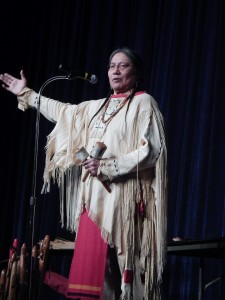
Cheyenne flute man Joseph FireCrow. The Grammy and Nammy award-winning artist performed for Gateway students on March 13. (Photo submitted)
HUNTINGTON – “I am a Northern Cheyenne fluteman,” Joseph FireCrow said as he introduced himself to students at Gateway Regional Jr./Sr. High School on March 13.
FireCrow was at Gateway to do an assembly tied to English Language Arts, U. S. History, and Social Studies units on Native American history and culture. The Gateway Education Foundation funded his appearance through a Funds for Learning grant submitted by high school English teacher Rod Kleber.
FireCrow shared that the history of his people had been handed down for centuries in an oral tradition, not written out. “We looked into a person’s eyes and saw how they would stand and breathe as they told their stories.”
The drumbeats of their songs represented the “heartbeat of our people,” FireCrow explained as he performed a song whose lyrics translated to, “Whatever happens this day, that is what is supposed to happen. Carry a good heart, an honest heart.”
FireCrow discussed his native dress, his flutes and drum, his bow, and some of the ceremonial and medicinal plants that were part of his tribe’s culture. Tobacco, he said, was one of the most powerful medicines in his tribe. But members had to be adults to use it, it was grown and dried naturally, and did not contain the additives that are in commercial tobacco. “It is used in offerings and to heal wounds,” he said. “But we do not inhale. The smoke itself connects the spiritual and material world.”
He demonstrated his flute playing and showed how he creates each flute using only natural materials. Measurements are made using forearm, fist, and thumb—not a ruler or yardstick. Each flute is carved from two pieces, then assembled using tree sap and elk sinew.
Longstanding traditions were handed down generation after generation, until the Europeans arrived. “They brought horses and metal and everything changed for my people.” Even the size of hunting bows changed in order to be used on horseback.
FireCrow also showed his shield, which was not only for defense but also for telling a warrior’s (man’s) life story. FireCrow’s was centered with a red dot marking his soul and contained a yellow dot denoting his spirit, three blue dots for his children, a purple dot for his wife, a thunderbolt identifying him as a man, an elk representing the gift of the flute to his people, and red-tail hawk feathers identifying him as a Cheyenne.
FireCrow described what it was like attending the Grammy Awards and meeting Paul Simon, Beyonce, Bruce Willis, the Temptations, and Tony Bennett. The Grammy and NAMMY (Native American Music) award winner was modest about his achievements. “Where I come from, when you do something remarkable, you are supposed to be humble. You don’t receive awards. You are expected to give away your gifts, not receive them.”
His final performance was of a drone, or duo-chambered flute. The music was haunting, with the flute playing two notes simultaneously.
Students and staff gave FireCrow an enthusiastic standing ovation at the end of the assembly.
FireCrow’s music has been featured in Ken Burns’s soundtrack of the documentary “Lewis and Clark: The Journey of the Corps of Discovery” and also featured on PBS’s “The War That Made America” film. He was the 2003 NAMA Songwriter of the Year and Flutist of the Year, earned a 2010 Grammy for Best New Age Album, and was both Flutist of the Year and Artist of the Year at the 2010 Nammmy Awards for his album “Face the Music.”

